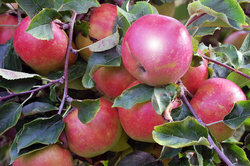Apple tree: this is how you recognize a disease caused by fungal attack
Most apple tree varieties are actually not really susceptible to disease. But if it has hit an apple tree, it is usually a fungal disease. Then you need to act quickly so that the fungus does not spread or spread to other fruit trees.

The existence Apple tree is affected by a fungal disease, you can usually first recognize it by the leaves. It is therefore important that you do not only pay attention to the tree when it is harvested, but that you check the foliage from time to time after it has sprouted. You can recognize the following diseases by their typical appearance.
Powdery mildew - this is how you can recognize it on the apple tree
- White powdered shoots and young leaves are typical of the early stage of powdery mildew.
- As the disease progresses, the leaves roll up.
- Realize that mildew in good time, it is often sufficient to remove the affected shoots and leaves. Only when the disease continues to spread should you spray the apple tree.
Fruit tree cancer does not only affect apple trees
- This dangerous disease penetrates the bark and wood through injured areas. You can recognize fruit tree shrimp by brown or orange discolored areas of the bark that are dry and cracked. In autumn, spherical spore beds form.
- If branches or the trunk of older trees are infested, they can certainly live with the disease. However, younger trees can die off completely.
- Only a radical cure can help against this disease: Infested parts of the tree must be sawn off and burned. Please do not forget to thoroughly disinfect the saw afterwards.
The apple tree is quite robust, but diseases can still occur. Use …
Apple scab shows up on leaves and fruits
- In the early stage of the apple scab, the leaves first show dull olive-colored, then brown and finally blackish spots, which can lead to complete leaf loss. The discoloration may remind you of the dangerous sooty in black Roses.
- The apples show scabbed, dark spots, in the course of which star-shaped cracks can form. The infestation is safe for consumption, but putrefactive agents can penetrate through the cracks, which have a negative impact on the shelf life of the fruit.
- You can treat the disease with sprays.
Fire blight is very dangerous and must be reported
- The most dangerous disease is the fire blight, which unfortunately lives up to its name. The tree shows only sporadically, then more and more areas that look as if they had been through a fire. Young, infested trees die within a few weeks, older trees after a few years.
- If the leaves and flowers of one or more trees suddenly wither for no apparent reason (storm, outer Violence or the like) you have to act quickly, because the disease is because of your risk of spreading notifiable. To do this, contact the State Office for Agriculture. From there, further measures will be initiated.
Preventive measures against fungal attack
Humidity and warm temperatures are good breeding grounds for fungal diseases. Unfortunately, you cannot influence the weather, but a few precautionary measures reduce the risk of an infestation.
- The susceptibility to fungal diseases depends on the variety. If you want to plant a young apple tree, it is best to ask a tree nursery for a suitably robust variety.
- In the fall, remove consistently in the area of the Fruit trees the dead leaves from the ground.
- You should always treat wounds on the trunk or branches with a special wound closure agent. This applies not only to injuries caused by storms or the like, but also after every fruit tree cut.
- Make sure you have a knowledgeable pruning for a treetop that gives the leaves good ventilation and quick drying after rainfall.
- Disinfect the cutting tools used after each pruning.
How helpful do you find this article?

